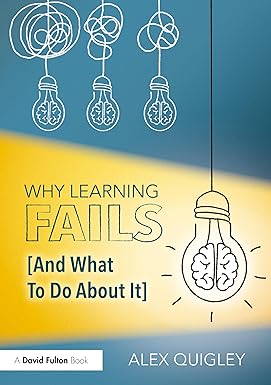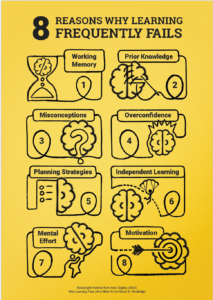A review of Alex Quigley’s Why Learning Fails (And What to Do About It)

The first lesson I ever taught was a failure. Despite my best planning and the strategies I knew at the time, the exit tickets showed that I had missed the mark. I had an idea that this was the case when a student immediately approached my supervising teacher and asked him to explain what I had just taught. Eleven years later and with much growth as a teacher, I have experienced many more failures in the classroom. Perhaps you have had a similar experience in your own teaching. If so, then we are the type of teachers for whom Alex Quigley wrote his 2024 book Why Learning Fails (And What to Do About It). “Failure,” Quigley states, “is one of the few consistent norms of every classroom. . . . If you are not failing—as a teacher or a pupil—then you are likely not tackling the types of challenges that maximize learning” (130).
After fifteen years in the classroom and many more supporting teachers, Quigley has distilled insights from dozens of research reports, articles, and books from the field of cognitive science to present a coherent overview of the causes of learning failures. His aim is that by “naming and framing the common problems that cause learning to fail, this book then offers substantive professional learning to support teachers in their pursuit of expertise” (139). Each chapter begins with an explanation of the issue, suggests a variety of evidence-backed solutions, and provides frequent summaries throughout. Overall, Quigley’s work offers educators a diagnostic and treatment manual for eight of the most common roadblocks to learning.
Why Learning Fails
Imagine Blake, an eighth grader who has been near-chronically absent since second grade. After missing twenty or so school days a year over the previous six years, he has lost the equivalent of nearly a full year of school. Blake’s work is sloppy, he has trouble completing assignments, and he rushes through his work as quickly as possible. Where can a teacher even start to intervene with a student like this? Quigley has some ideas.

Through naming eight common learning obstacles, teachers can gain a sense of what precisely is happening in the brain of a student like Blake. The learning failures are 1) limits on working memory, 2) gaps in prior knowledge, 3) student misconceptions, 4) overconfidence, 5) poor planning strategies, 6) lack of independent learning skills, 7) scattered attention, and 8) failing motivation as a result of failure (6). Each of these can present on its own or in conjunction with any number of the others. Indeed, one learning failure often leads to another over time.
A student like Blake, then, has profound gaps in prior knowledge and as a result has developed numerous misconceptions in trying to interpret all of the content his teachers present to him. He does not know how to plan to learn effectively or independently. Consequently, he is deeply unmotivated by learning because he has come to believe that he is not “good” at school. Not every student is in such a bad position academically, but every student will experience some of these challenges in their education. Armed with the knowledge from Quigley’s book, a teacher can begin to plan out effective classroom strategies to help Blake, and any student like him, overcome these obstacles.
And What to Do About It
How might a teacher work with a student like Blake, whose time in school has been marked by failure? Or perhaps, how can the teacher who feels like their best efforts are inadequate adapt their teaching in a classroom that continually feels like a slog? After thoroughly explaining each learning obstacle, Quigley concludes each chapter with multiple strategies optimized to help teachers address the specific challenges and support students at their stage of cognitive development.
One of the themes Quigley emphasizes is that in order to become confident learners, students must have an age-appropriate understanding of how their brains work. For Blake’s teachers, Quigley may suggest they get him to “think aloud” so that they can pinpoint gaps in his knowledge (33). They may also employ concept mapping with specific graphic organizers to help him form stronger knowledge schemas (27). “Contrasting examples” that demonstrate clearly what the content does not mean can also inoculate students against misconceptions (49).
To build confidence and wherewithal for learning, Quigley suggests that teachers use “learning sprints” (107). He explains that “learning sprints are about breaking down complex tasks into smaller steps that get around the limits of both working memory and human attention spans (108). Blake’s teachers might consider setting more specific goals focused on effort, emotions, or self-regulation, depending on their content, so that he learns to learn independently (122).
More broadly, his teachers ought to nurture a “culture of error” (Lemov qtd. in Quigley 48) in which students are comfortable to make mistakes and learn from them. This psychological safety in the classroom that encourages smart risk-taking without fear of mocking, derision, or teacher exasperation is essential for significant learning (124–25). This is an abridged version of this article. To read more, subscribe to the print or digital edition of Christian Educators Journal.
Work Cited
Quigley, Alex. Why Learning Fails (And What to Do About It). Routledge, 2024.
Eric Wildermuth is the Director of Advancement at the Christian Academy in Brookhaven, PA. Previously, he taught Bible and history in middle and high school for eight years. Eric lives outside Philadelphia with his wife, Janel, and their two wonderful toddler boys.